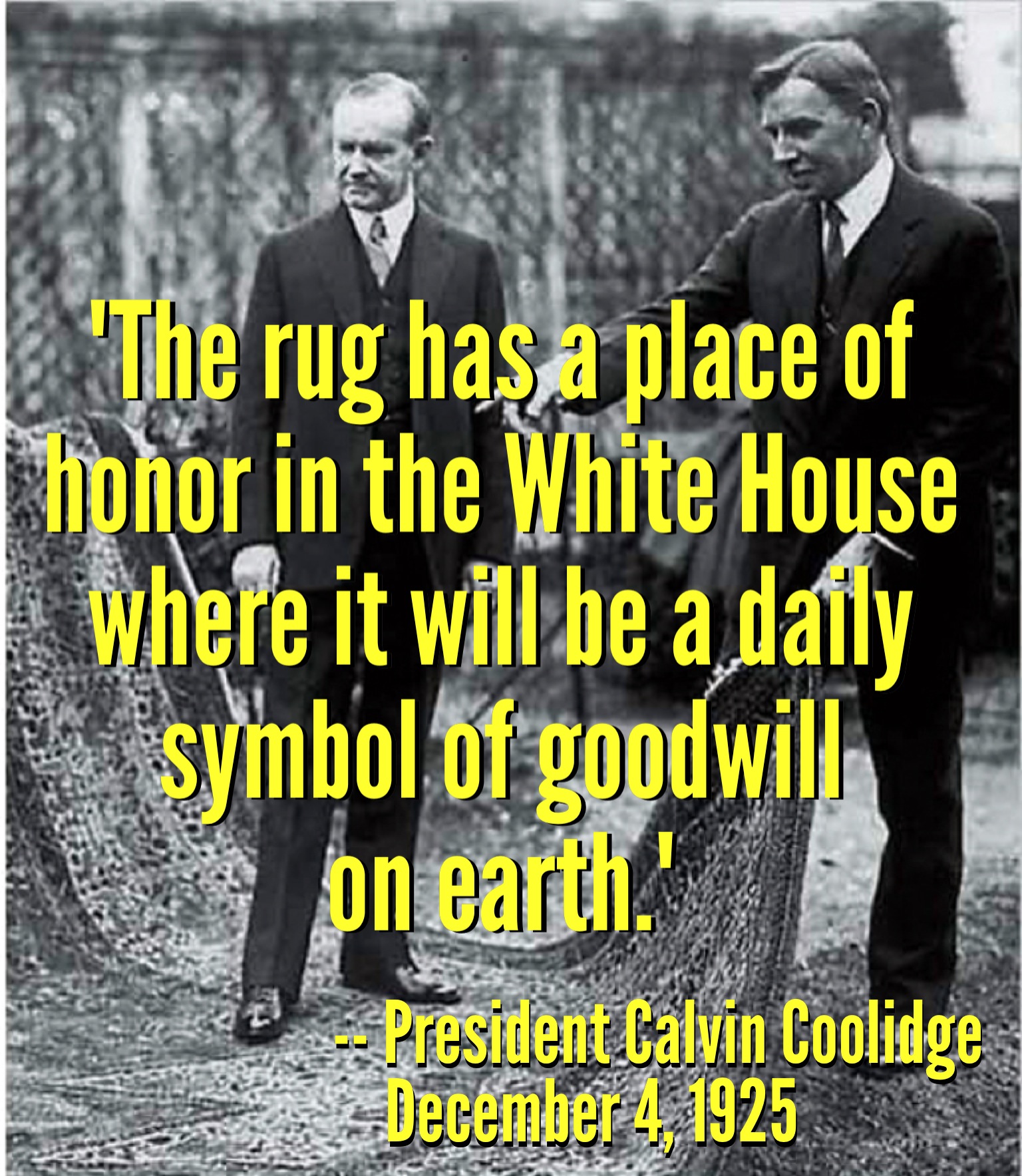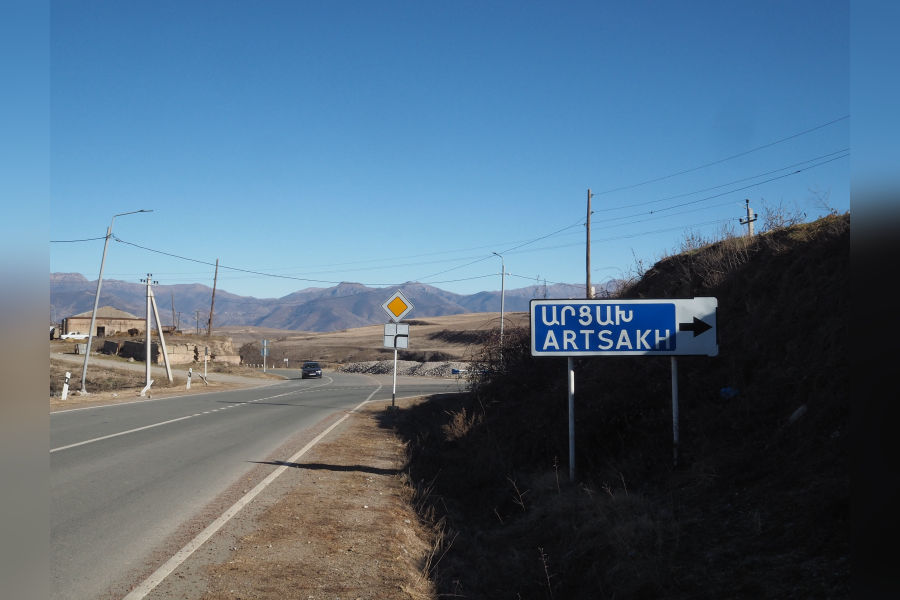
WASHINGTON, DC—The Obama Administration has advised Congressman Adam Schiff (D-CA) and Senator Ed Markey (D-MA) that the White House will be making the Armenian Orphan Rug—woven by young survivors of the Armenian Genocide and presented as a gift to President Calvin Coolidge in appreciation of U.S. relief efforts for the survivors of this crime—available for public display at an event to be held as early as Fall, 2014, reported the Armenian National Committee of America (ANCA).

The announcement was welcomed by both Congressman Schiff and Senator Markey, who had joined with Congressional colleagues in petitioning for the release of the iconic symbol of U.S. humanitarian assistance following reports that the White House had refused to allow its display at an event that was to be held at the Smithsonian Institute in December, 2013.
“Since first raising this issue with the Administration, I have worked diligently with the White House to find a way for the Ghazir rug to be sensitively and appropriately displayed,” said Rep. Schiff. “Today, I’m pleased to be able to say that planning is underway for the Armenian Orphan Rug to be displayed as early as this Fall. I have worked out with the White House that the display will take place in a venue that is open to the general public, and I appreciate their willingness to place this significant artifact on display for all to see.”
Sen. Markey concurred, noting that “the Armenian Orphan Rug is an important symbol of the longstanding friendship between America and Armenia. Displaying this significant piece of history will serve as reminder that we will never forget the Armenian Genocide and highlight the continued need to work towards its proper recognition. I commend President Obama and the White House for working with me and my Congressional colleagues to ensure that this rug is given the historic exhibition it truly deserves.”
The news was also hailed by Congressman David Valadao (R-CA), who, along with Congressman Schiff, is lead sponsor of the Armenian Genocide Resolution (H.Res.227) and led a bipartisan Congressional effort to secure the release of the Armenian Orphan Rug. “For over a decade, Armenian-American organizations have been asking the White House and the State Department to display the Ghazir Rug publically,” said Rep. Valadao. “Today’s announcement by the White House is an important first step towards ensuring the Armenian Genocide is recognized by our current Administration. My Congressional District, CA-21, is home to a large population of Armenian-Americans, who have a strong presence in our community. As their Representative, I am pleased the Administration has decided to fulfill our request to publicly display the rug. The Armenian Orphan Rug is a shared piece of American and Armenian history that belongs to the American people.”
ANCA Executive Director Aram Hamparian warmly welcomed the longstanding efforts of Rep. Schiff, Senator Markey, and Rep. Valadao to seek the public, prominent display of the rug, but noted that vigilance remains the key to ensuring that the rug presentation does, in fact, take place.
“It’s a testament to the Turkish government’s continuing grip over the Obama Administration’s policy on the Armenian Genocide that it has taken years of Congressional and community effort to secure the public display of a rug woven by the child survivors of this crime—a unique artifact that, it must be stressed, is a piece of U.S. property and a meaningful part of American history,” said ANCA Executive Director Aram Hamparian. “We applaud the efforts of Congressman Schiff, Senator Markey, Rep. Valadao and others to secure the public display of this rug and will continue to track this matter closely in the coming weeks and months.”
The controversy surrounding the Armenian orphan rug erupted in October, 2013, when the Washington Post and National Public Radio reported the White House’s abrupt and unexplained reversal of its agreement to lend the rug for a December 16, 2013, exhibition at the Smithsonian Institute, organized in cooperation with the Armenian Cultural Foundation and the Armenian Rug Society. In an interview with Public Radio International (PRI), Washington Post Art Critic Philip Kennicott noted that while the White House has not offered an explanation for the reversal in decision, it is likely due to the U.S. government’s deference to Turkey’s international campaign of genocide denial.
Click here to listen to the PRI interview in its entirety:
http://youtu.be/jlIhbS78-Yg
Following these initial reports, the ANCA organized a nationwide grassroots campaign, worked with Members of Congress, and consulted with the Administration, making the case to all relevant stakeholders for the prominent and permanent public display of this historic rug.
In November, 2013, a bipartisan group of over 30 U.S. Representatives, led by Representatives Schiff and Valadao, called on the White House to reverse its decision. Senator Markey and Representatives Brad Sherman (D-CA) and Nikki Tsongas (D-MA) also sent personal letters urging the White House to take action.
During an ANCA Western Region press conference timed with President Obama’s visit to Los Angeles on November 26, 2013, His Eminence Archbishop Moushegh Mardirossian, Prelate of the Western Prelacy of the Armenian Apostolic Church noted, “The rug was a gracious gesture symbolizing the friendship between the American and Armenian peoples. It is part of American history. Keeping it locked away in storage is not only insulting to the orphaned girls who painstakingly crafted this beautiful work of art, it also represents a shameful effort to cover up, at the urging of genocide-deniers in Ankara, a truly proud chapter of American history.”
The White House response at that time was vague—with National Security Staff Assistant Press Secretary Laura Lucas Magnuson offering the following comment to the Asbarez Armenian Newspaper: “The Ghazir rug is a reminder of the close relationship between the peoples of Armenia and the United States. We regret that it is not possible to loan it out at this time.” A statement with the same exact wording was released to the Washington Post at the time.
LA Times reporter Richard Simon reported the White House change of position, with Magnuson affirming that the White House has “been working with Congressman Schiff on this issue for several months and appreciate his working with us to showcase this important artifact in a way that appropriately highlights the spirit in which it was given to the White House for U.S. involvement in assisting Armenian refugees.”
Simon’s complete Los Angeles Times article is available at:
http://www.latimes.com/nation/nationnow/la-na-nn-armenian-rug-white-house-20140430,0,1080767.story#ixzz30OhpnJ27
The Armenian orphan rug measures 11′ 7″ x 18′ 5″ and is comprised of 4,404,206 individual knots. It took Armenian girls in the Ghazir Orphanage of Near East Relief ten months to weave. The rug was delivered to President Coolidge on December 4, 1925, in time for Christmas, with a label on the back of the rug, which reads “IN GOLDEN RULE GRATITUDE TO PRESIDENT COOLIDGE.”
According to Missak Kelechian, an expert on this topic, the gift of the Armenian Orphan rug was widely covered in U.S. media, including in the New York Times in 1925 and the Washington Post in 1926.
Kelechian describes the journey of the rug in a CNN clip available here.
http://youtu.be/YyDoZl7bYN8
Additional information about the history of the Armenian Orphan Rug is available in Dr. Hagop Martin Deranian’s book, President Coolidge and the Armenian Orphan Rug, published on October 20, 2013, by the Armenian Cultural Foundation.









“The Story of Near East Relief” has an introduction by Calvin Coolidge. This is a book everyone should read; it explains the history of the humanitarian work done to help the orphans; plus a history of the region, which will aid in your understanding of what happened; plus pictures of the poor orphans, who look like the emaciated victims of Nazi concentration camps (some of who died in the refugee camps, and others who were saved by the relief organization).
The White House and the United States administration in general treats the Armenian Genocide issue as an “abomination” not to touch, when they ready to offer advice to the rest of the world on every subject under the sun. When pressed on the Armenian Genocide issue they seem to loose their mastery on vocabulary and they become tongue tied. Either we as a community of Americans of Armenian origin are too weak politically or Turkey has a hold on our politicians that count of the national scene. The fact that they made such a fuss on displaying this carpet, makes me wonder whether they are even ready to disclose the nature of archives at their disposal on Armenian Genocide.
I feel so good that I wrote a letter to President Coolidge’s Library in Stow Vermont. I also wrote a nice letter to President Obama a similar letter, asking him to display what our grandmother’s knitted and sent it as a gift to then president Calvin Coolidge.
I am sure many of you have written similar letters urging those in charge to display this rug.
This is how we achieve any objective. This how we accomplish any mission. Each and everyone of us must get involved. We should all knock on every door by writing, texting, emailing, calling and make everyone aware of failure policies of our representatives.
Let this initiative be a beacon for hope and a motto for success.
Always, United we Stand and Devided we fall. God Bless America and God Bless Armenia.
Getse hay joghovourt,
We are all Armenians.